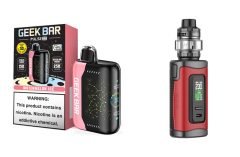Table of Contents
Clearomizers – What you need to know
For many people just getting started with vaping with e cigarettes, (and trust me, all of us were new at some point in recent history.) one of the more puzzling questions is a variation of, “Can I use this on my e cigarette?” While the question can be plenty frustrating, the answer is just as mightily exhilarating. Let me guide you to that answer.
Before we get properly started, though, I always like to explain some terms I’m going to use which you may or may not have encountered before:
PV: Personal Vaporizer; otherwise called an electronic cigarette or e-cig, e cigarette, or cig-a-like. I like to call them PVs simply for the obvious reason that that’s what they do — they produce vapor.
APV: Advanced Personal Vaporizer: The “advanced” is for functions such as variable voltage and variable wattage, allowing the user to change how much electrical current flows into the…
AD: Atomization Device. This is my own catch-all term for cartomizers, cartomizer tanks, clearomizers, rebuildable dripping atomizers, et al. Just a nice, quick way to say, “whatever you put your juice in and attach to your PV.”
Okay, then. Onward!
When it comes to battery-based systems like the eGo (and all its myriad variations) and the iTaste VV, or even Advanced Personal Vaporizers (APVs) like the Vamo, the iTaste SVD, or the iTaste 134, things have a tendency to get really technical really quickly. There is most definitely a slight learning curve involved with vaping with e cigarettes, mostly by virtue of the simple fact that minor electronics are involved. Luckily, it’s not brain surgery so all it takes is a little bit of reading, a little bit of tinkering, and a little bit of common sense. Anyone can become an expert in this stuff, and quickly.
Fortunately, when it comes to a specific question like which clearomizer or cartomizer will work with which device is relatively straightforward, if not entirely non-technical. When it comes to creating a good pairing between atomization device (clearomizer, cartomizer, tank) and power source (battery or battery-powered device), we don’t so much have to worry about the mAh rating — we only need to pay a modest amount of attention to voltage, at least on fixed-voltage power sources, like any cig-a-like, eGo and Spinner devices with a number like 650, 900, 1100, and 1300 preceding it. And by the way, those numbers are mAh ratings, as in a 650 eGo has a mAh rating of 650 — the only thing that we really have to focus on today is the connection type.
There are three connection types that are, at this point, really dominate in the hardware side of the vaping scene right now. Let me go through each one by name and provide the most notable examples of hardware — both on the PV side and the AD side — that use it.
510: This connection type is by far the most commonly used, to the point that it even appears on batteries and APVs that are also equipped with eGo threading. Practically every PV that has eGo threads also has 510 threads. You’re likely to hear things like 510-threads, or 510-connector, and all that means is that the clearomizer or cartomizer, et al, needs to have a 510-thread connector.
However, the reverse is not always the case — some devices, particularly many mechanical mods (battery powered electronic cigarettes without electronics, very similar to a basic flashlight really) and many of the “cigarette lookalike” devices (we call them cig-a-likes here) , have 510-connections but do not have eGo threading. The SMOKTech Magneto or the just reviewed GS Matrix 3 is a perfect example of that, as is the Blu Cigs series of cigarette-sized (cig-a-likes) PVs, as is the Johnson Creek Vea, which is actually very nearly an eGo size device but lacks eGo threads. Stay with me here, it gets easier, I promise.
The AD (atomizer device or clearomizer, cartomizer, tank) side of hardware, though, is where the connection types really get diverse, and this is where you need to pay special attention when you make your purchasing decisions.
eGo: Following on from 510 connections, I would rate eGo connections as the second most prevalent type, but only by a hair, and only because, as noted, there are two whole categories of PVs that primarily have 510-only connections. On just about everything else from the actual eGo battery PVs and on up to the biggest and most powerful APVs, you can practically count on seeing eGo threads on the outside of a 510-connector post. You can screw IN a 510-cartomizer or tank, and screw ON an eGo or Spinner battery.
808: The third most common connection type — though coming in at a very distant third these days — is the 808 connection standard, or as it is fully laid out: KR-808-D1. This connection type is almost exclusively associated with cigarette lookalike devices (cig-a-likes) such as the Halo G6, or the cig-a-likes from Triple 7, and one very noteworthy exception is the Triton tank-based PV also sold by Halo. This is an eGo-sized and mAh rated battery that also uses an “808” threaded clearomizer or an 808 cartomizer.
Back At The mAh
Now let us, for just a moment, get into a couple of the other numbers associated with the PV side of the hardware. The first of those is the mAh rating. All the mAh number dictates is how much electrical storage capacity the battery offers. A higher number doesn’t mean a better vape — it only tells you how long you can vape on your fully charged battery before the battery is depleted and needs to be charged again. Again, when you see or read about a 650mAh eGo, or a 1300mAh Vision Spinner battery, they are only referring to the amount of power stored in the device.
The other number is the voltage output — on basic PVs, this is almost always fixed at between 3.7 and 4.2 volts, with the voltage slowly decreasing as the battery goes from fully charged to depleted in “unregulated” batteries. The exception to this is the Johnson Creek Vea, which starts out at 2.8 volts and, therefore, is really best used with Johnson Creek’s cartomizers or mini-clearomizers, because they’re designed to perform perfectly at that lower voltage output.
Conclusion
In conclusion, when you’re shopping for or reading about, a new atomization device (AD, which is… say it with me now “Cartomizers, Clearomizers, Tanks) and want to know whether it will work with the PV, or personal vaporizer, or APV, or cig-a-like, you already have, the only technical thing you really need to look for is the connection type, otherwise described as the threads.
Example: If your battery, for example, bears a 510 connection but doesn’t also have eGo threads, you want to make sure to find 510-compatible atomization devices. If you have a device with eGo threads, on the other hand — which invariably also have 510 threads on the same connector — then you can use any AD that has either 510 or eGo threads.
So there it is in a nutshell. Happy shopping, happy reading, and happy vaping!
John Castle





